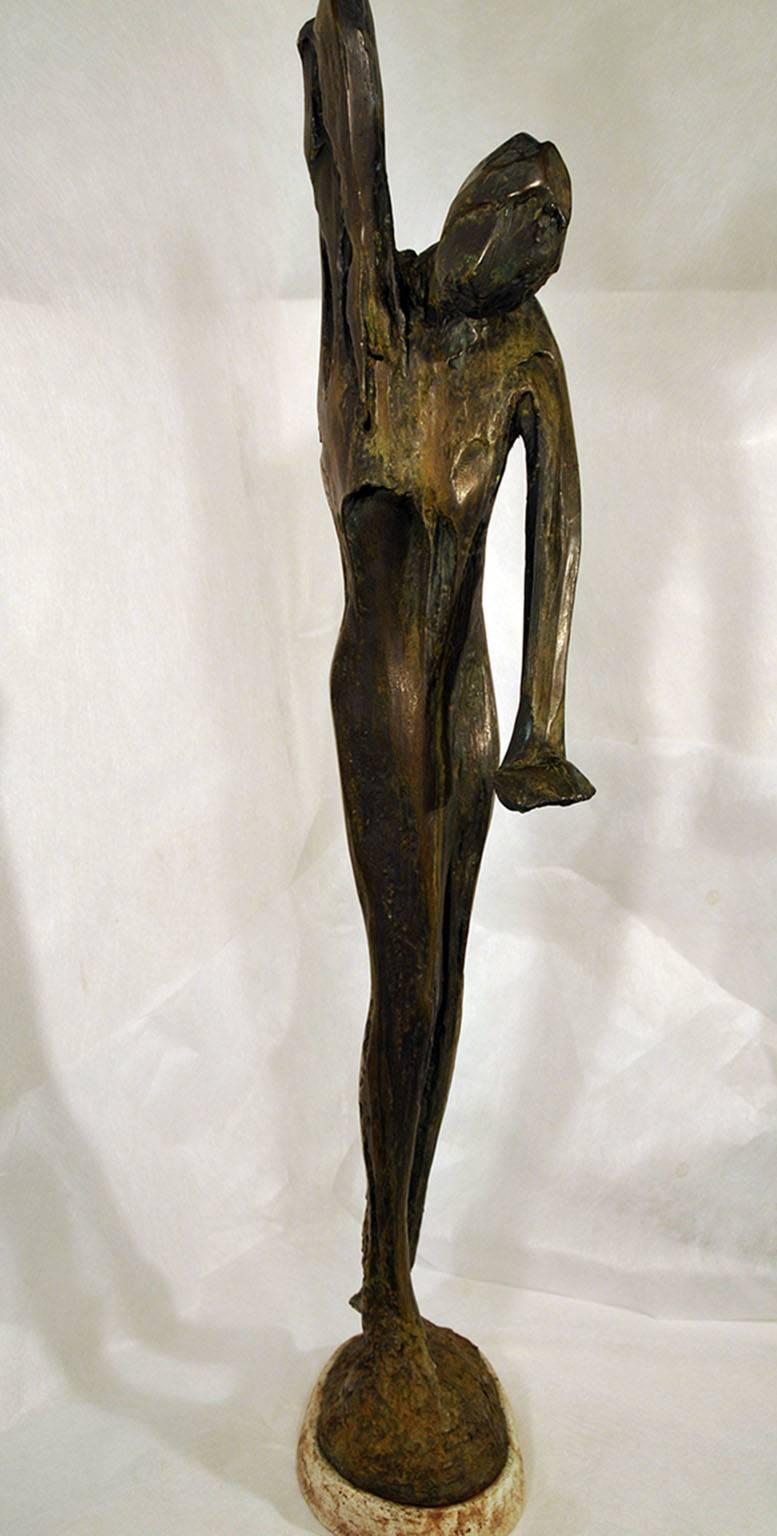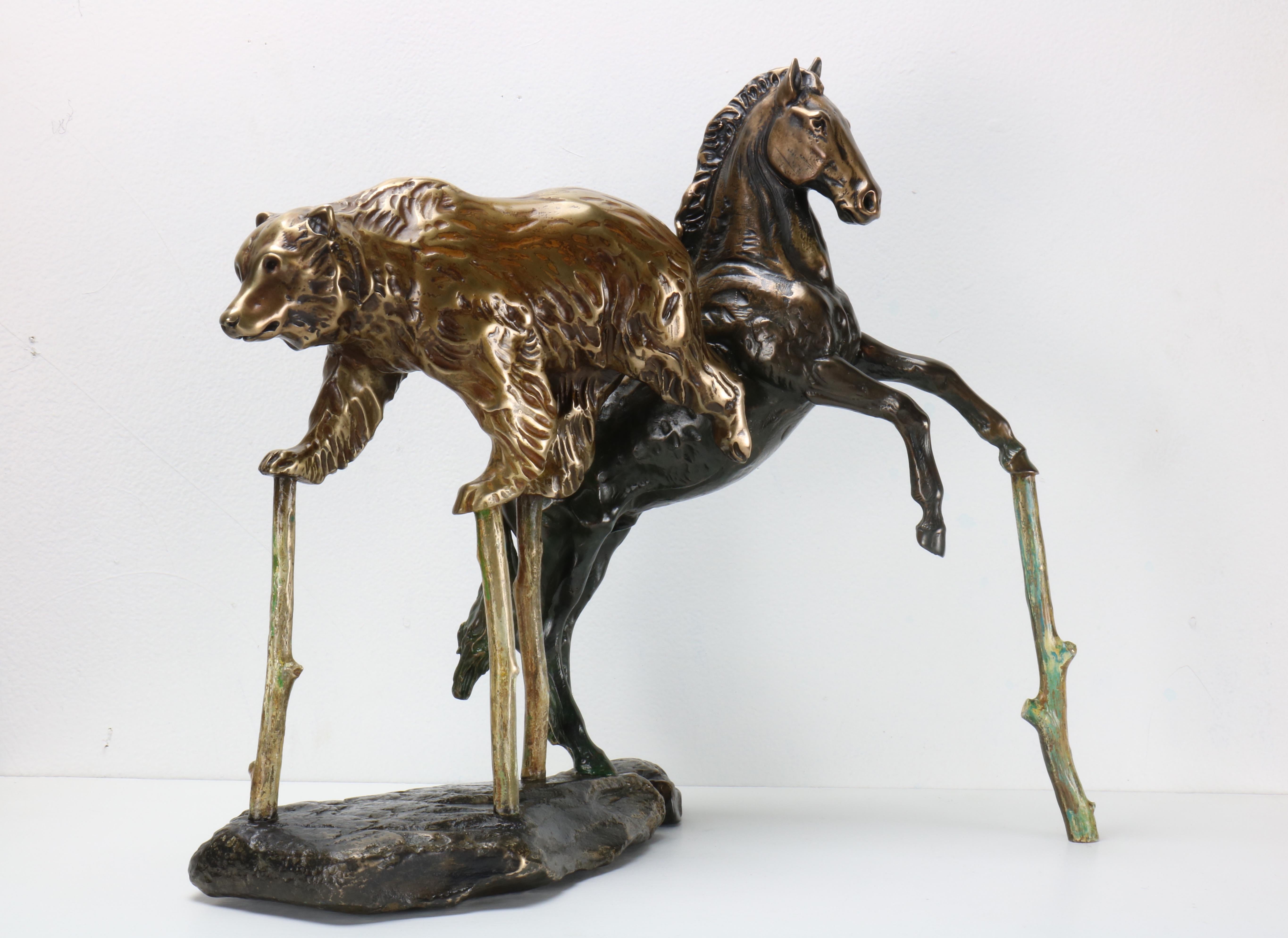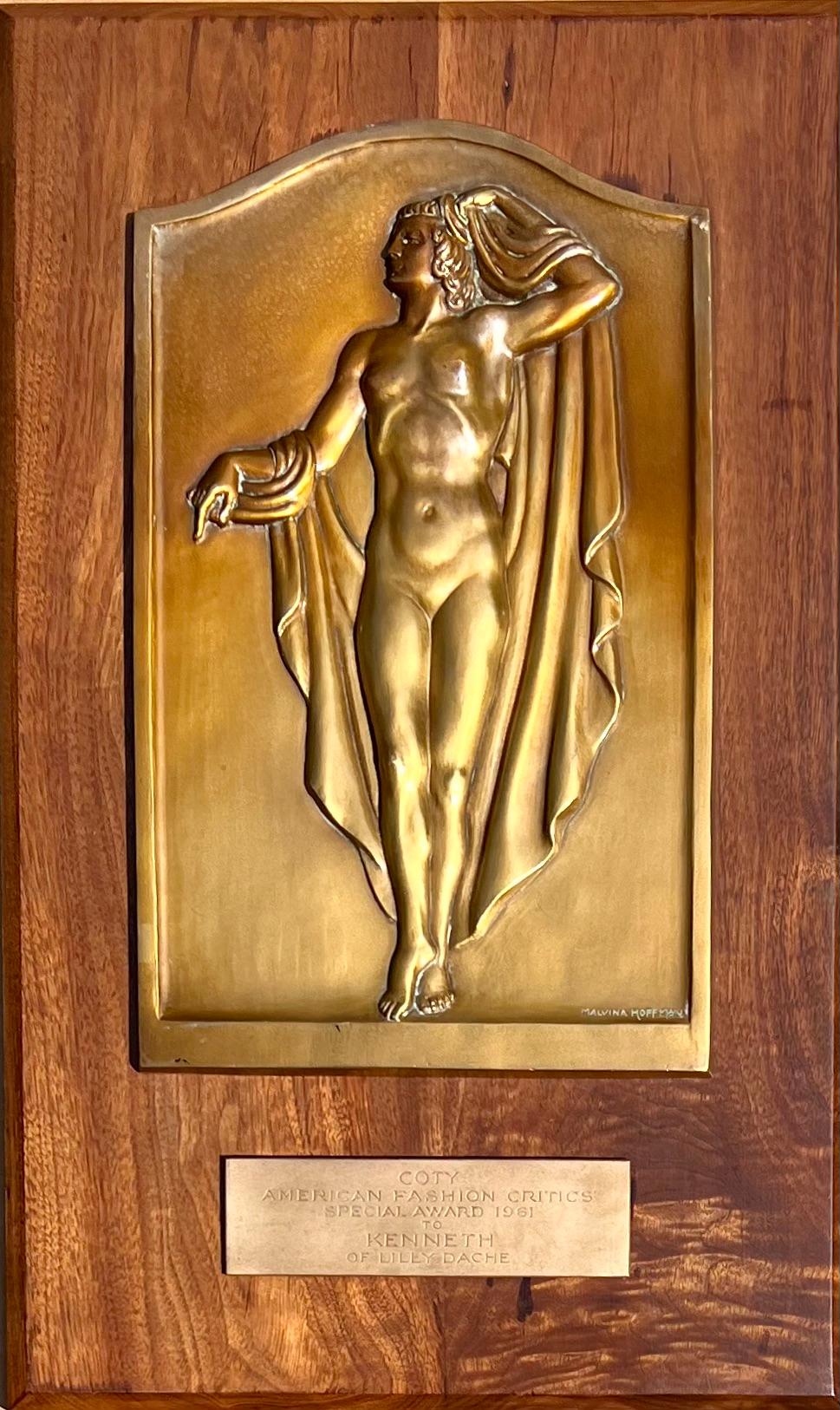Items Similar to "Man on a Stair" American Scene Social Realism WPA Mid 20th Century Modern
Want more images or videos?
Request additional images or videos from the seller
1 of 5
Robert Cronbach"Man on a Stair" American Scene Social Realism WPA Mid 20th Century Modern1940
1940
About the Item
"Man on a Stair" American Scene Social Realism WPA Mid 20th Century Modern
Robert M. Cronbach (AMERICAN / NEW YORK / MISSOURI, 1908 - 2001) modernist bronze sculpture depicting a standing man by a stairwell holding a book. Signed to signed of base and dated 1940. Has Modern Art Foundry, New York to verso of base. Measures approx. 12 1/4" height x 7 3/4" width x 4" depth.
BIO
American sculptor and teacher, Cronbach was born in St. Louis, Missouri where he began his art studies. He is best remembered for his medals, architectural sculpture and other works.
His art studies continued at the Pennsylvania Academy of Fine Art where he won two Cresson Traveling Scholarships and travelled to Europe in 1929 and 1930.
During 1930 he worked as an assistant to Paul Manship.
In 1938 he was one of the 57 Founding Members of the Sculptors Guild. He also created sculpture under the auspices of the Works Progress Administration's Federal Art Project.
Cronbach taught sculpture at Adelphi College in Garden City, New York from 1947 to 1961.
He was one of 250 sculptors who exhibited in the 3rd Sculpture International held at the Philadelphia Museum of Art in the summer of 1949. Cronbach was represented by the Bertha Schaefer Gallery, New York, NY.
Cronbach died in 2001 in San Miguel de Allende, Mexico.
- Creator:Robert Cronbach (1908 - 2001, American)
- Creation Year:1940
- Dimensions:Height: 12 in (30.48 cm)Width: 8 in (20.32 cm)Depth: 4 in (10.16 cm)
- Medium:
- Movement & Style:
- Period:
- Condition:
- Gallery Location:New York, NY
- Reference Number:1stDibs: LU1156214202772
About the Seller
5.0
Gold Seller
These expertly vetted sellers are highly rated and consistently exceed customer expectations.
Established in 2008
1stDibs seller since 2019
165 sales on 1stDibs
Typical response time: <1 hour
- ShippingRetrieving quote...Ships From: Pawling, NY
- Return PolicyA return for this item may be initiated within 3 days of delivery.
More From This SellerView All
- 1961 Coty Award Plaque Kenneth Hairdresser Jacqueline Onassis Bronze FashionLocated in New York, NY1961 Coty Award Plaque Kenneth Hairdresser Jacqueline Onassis Bronze Fashion Bronze on wood. The wood plaque measures 12 3/4" by 20 3/4 inches. The bronze plaque itself is 13 3/4 x 8 3/4 inches and the the bronze inscription, which reads "COTY, American Fashion Critics Special Award 1961 to KENNETH of LILY DACHE...Category
1960s American Modern Figurative Sculptures
MaterialsBronze
- "Pioneer Family" WPA American Modernism Plaster Maquette Realism 20th CenturyBy William ZorachLocated in New York, NY"Pioneer Family," 23 1/2 x 16 1/4 x 10 3/4 inPlaster. c. 1927. Unsigned. Realism The Smithsonian has a cast of this sculpture in its collection. Pictured on the cover of “The Sculpt...Category
1920s American Modern Figurative Sculptures
MaterialsPlaster
- Industrial Machine Age American Scene WPA Mid 20th Century 1939 SF World's FairLocated in New York, NYIndustrial Machine Age American Scene WPA Mid 20th Century 1939 SF World's Fair HAIG PATIGIAN (American/Armenian, 1876-1950) Aeronautics Pediments Two Plaster Casts, c. 1930s each 13.25 x 14.75 x 6 inches It's possible these moquettes were created for the 1939 World's Fair, the Golden Gate International Exhibition in San Francisco. Provenance: Private Collection of Lois M. Wright, Author of "A Catalogue of the Life Works of Haig Patigian, San Francisco Sculptor, 1876-1950),” 1967 Loan to Oakland Museum of California (Oakland, CA) BIO Haig Patigian is noted for his classical works, which are especially numerous in public venues in San Francisco, California. Patigian was born in Van, Armenia, which at that time was under Turkish rule. Haig was the son of Avedis and Marine Patigian, both teachers in the American Mission School there. He and his older brother showed an aptitude for art early on and were encouraged by their parents. Their father himself had taken up the new hobby of photography. The 1880s were harsh times, however, for many Armenians under an oppressive rule by the Turkish government. Many people were fleeing to the safety of the United States. Suspicious Turkish authorities accused his father of photographing city structures for the Russian government, and in 1888 he fled for his life to America. Haigs father made his way to Fresno, California, and began life anew as a ranch hand. Within two years he sent for his wife, as well as Haig, his three sisters and brother, and in 1891 the Patigians made the journey from Armenia. Haigs father, an industrious man, worked on various farms, and eventually bought his own ranch and vineyard. It was among fertile farmland of Fresno that Haig grew up. Young Haigs education consisted of teachings by his parents and by intermittent attendance in public schools. Although he had dreams of becoming an artist, he did not have the opportunity for formal study of art, and began working long days in the vineyards around Fresno. At age seventeen, Haig made a step towards his dreams and apprenticed himself to learn the trade of sign painting. In his spare time he nurtured his interest in art by painting nature and life scenes with watercolors and oil paints. When his sign-painting mentor left Fresno, Haig opened his own shop and made a name for himself in the town. San Francisco, in the meantime, had been attracting artists since the Gold Rush and had become a thriving art center. Within a few years, Haig had put aside several hundred dollars to move to San Francisco, joining his brother who was already working there as an illustrator. In 1899, when he was twenty-three, Haig had saved enough money to enroll at the Mark Hopkins Art Institute in San Francisco. Like many aspiring artists of his time, Patigian supported himself by working as a staff artist in the art department of a local newspaper, and in the winter of 1900, nearing his 24th birthday, Haig began work for the San Francisco Bulletin, producing cartoons, black and white illustrations, as well as watercolors. In 1902 tragedy struck Haig and his family. His 29-year-old brother died of pneumonia, and then his frail mother died a short time later. Five months more saw his youngest sister, just out of high school, die too. Saddened and depressed, Haig moved out of the studio he had shared with his brother, and into a dilapidated studio in a poor section of town. During this time of sadness, Haig fed a growing interest in sculpture. In 1904 Haig created what he later called his "first finished piece in sculpture". The work, called "The Unquiet Soul", depicted a man thrown back against a rock while waves lash at his feet. The body was tense and twisted, with one hand, in Haig's own words, "searchingly leaning and clutching the rock, while the other masks his troubled head". The Press Club of San Francisco, which Haig had joined in 1901, put "The Unquiet Soul" on exhibition and local headlines proclaimed "Local Newspaper Artist Embraces Sculptor's Art", and "First Work Predicts Brilliant Future". With the support of friends and community acclaim, the young illustrator left his newspaper job and became a professional sculptor. The path of his new career was not easy though. Haig had never made much money working for the newspaper and his father needed help with growing debt from funeral expenses and business problems. From time to time Haig sold some artwork, but also occasionally borrowed from friends to pay the rent. He was the classic 'starving artist'. In the spring of 1905 a white-bearded 81-year-old stranger knocked on Haig's door. It was George Zehndner, from Arcata, California. Zehndner had been born in Bavaria, Germany in 1824, the son of a farmer. In 1849 he had come to America looking for prosperity, settling in Indiana, where he worked on a farm and learned English. He found his way to the West Coast in 1852. Penniless, he worked in various jobs from San Francisco to Sacramento, then found some luck working in the gold fields of Weaverville in Trinity County, and eventually moving to a farm on 188 acres near Arcata. In his 77th year in May of 1901, Zahndner had taken a trip to San Jose, where he stood in a crowd to see a man he thought much of, President William McKinley. McKinley was popular as 'the first modern president' partially because he realized going out to meet the common person increased his support. In September of that year, however, an anarchist assassinated the president while he stood in a receiving line at the Pan-American Exhibition in Buffalo, New York. Soon after, the city of San Jose erected a statue of the slain president in St. James Park. Zehndner took a second trip to San Jose where he visited the McKinley monument. Touched, Zehndner decided that, no matter the cost, his town of Arcata too would memorialize McKinley. George Zehndner had read about Haig in a newspaper article and asked if Patigian would create a heroic statue of the late President McKinley for Arcata. When asked how much it would cost, Haig responded, despite his borderline poverty, with the fabulous sum of $15,000. Zehndner agreed. The President was to be portrayed standing, wearing an overcoat, with his feet planted squarely on the ground. In the finished statue, one hand is held out before him in a typical posture of speaking, with the other hand holding the speech as his side. The 9-foot statue...Category
1930s American Modern Figurative Sculptures
MaterialsPlaster
- 2 Sculptures: "The Power" & "The Glory" WPA Depression WWII era mid 20th centuryBy Agnes YarnallLocated in New York, NY2 Sculptures: "The Power" & "The Glory" WPA Depression WWII era mid 20th century by Agnes Yarnall circa 1940s. Sculptor, painter, poet and artistic historian, Agnes Yarnall has, since the age of six been breathing life into her art. Renowned as a sculptor, whose commissioned portrayals of contemporary celebrities are prized. She has sculpted Judith Anderson, Edna St. Vincent Millay, Carl Sandburg...Category
1940s American Modern Figurative Sculptures
MaterialsPlaster
- Barge Toiler -Mid 20th Century Modern WPA Labor Plaster Depression-Era SculptureBy Max KalishLocated in New York, NY"Barge Toiler" by Max Kalish is a Mid 20th Century modern Depression-Era sculpture from his Labor series. The WPA era work is made of plaster. Max Kalish (1891 – 1945) Barge Toiler...Category
1930s American Modern Figurative Sculptures
MaterialsPlaster
- 1, 000 piece Museum Quality Collection of Art & Objects from NYC 1939 Worlds FairBy Harry LaneLocated in New York, NY1,000 piece Museum Quality Collection of Art & Objects from NYC 1939 Worlds Fair Harry Lane (1891-1973) "1939 World’s Fair Construction," 30 x 40 inches, Oil on canvas, signed lower...Category
1930s American Modern Landscape Paintings
MaterialsCanvas, Photographic Paper, Plaster, Oil
You May Also Like
- UpBy Robert CookLocated in New York, NYBronze, 1967. Height 59" (149.9 cm) width max 15" (38 cm). Signed on base "R Cook." This unique large sculpture was made using the lost wax process. “ . . . Inspired by a da...Category
Mid-20th Century American Modern Figurative Sculptures
MaterialsStone, Bronze
- Show of InterestBy Brad RudeLocated in Denver, COArtist Brad Rude was born in Montana and has lived in Walla Walla, Washington most of his life. His journeys through his grandfather's folk art studio left...Category
2010s American Modern Figurative Sculptures
MaterialsEnamel, Bronze
- Combined EffortBy Brad RudeLocated in Denver, COArtist Brad Rude was born in Montana and has lived in Walla Walla, Washington most of his life. His journeys through his grandfather's folk art studio left...Category
2010s American Modern Figurative Sculptures
MaterialsEnamel, Bronze
- Figure of a Woman Sleeping in a Rocking Chair by Bruno LucchesiBy Bruno LucchesiLocated in Brookville, NYThis bronze sculpture of a woman in a chair, is typical of the work of Bruno Lucchese. Born in Italy in 1926, Bruno Lucchesi has been referred to as “the last of the Renaissance scu...Category
1960s American Modern Figurative Sculptures
MaterialsBronze
- Construction & Garment Worker, WPA Bronze by Robert CronbachBy Robert CronbachLocated in Long Island City, NYArtist: Robert Cronbach, American (1908 - 2001) Title: Construction & Garment Worker Year: 1938 Medium: Bronze sculpture with Brown Patina, signature and date in the cast Size: 18 ...Category
1930s American Modern Figurative Sculptures
MaterialsBronze
- Hunter, Bronze and Wood Sculpture by James McCainBy James McCainLocated in Long Island City, NYArtist: James McCain, American (b. 1944) Title: Hunter Year: circa 1980 Medium: Bronze Sculpture on Wooden Base, signature and numbering inscribed Edition: 85/250 Size: 12.5 x 6 x ...Category
1980s American Modern Figurative Sculptures
MaterialsBronze
Recently Viewed
View AllMore Ways To Browse
Mid Century Modern Figurative Sculpture
Mid Century Modern Figurative Bronze Sculpture
Man Standing Sculpture
Mid Century Modern Architecture Book
Wpa Sculptures
Midcentury Modern Architectural Scene
Modernist Sculpture 1930
Bronze Sculpture Standing Man
St Louis Federal
Robert Schaefer
Adelphi Vintage
Colleen Shona
Feline Bronze Sculpture
Francisco Ribera Gomez
Gustavo Torres
Head Of David Statue Bust
Indonesian Shadow Puppet Wayang
Kaws Ceramic



